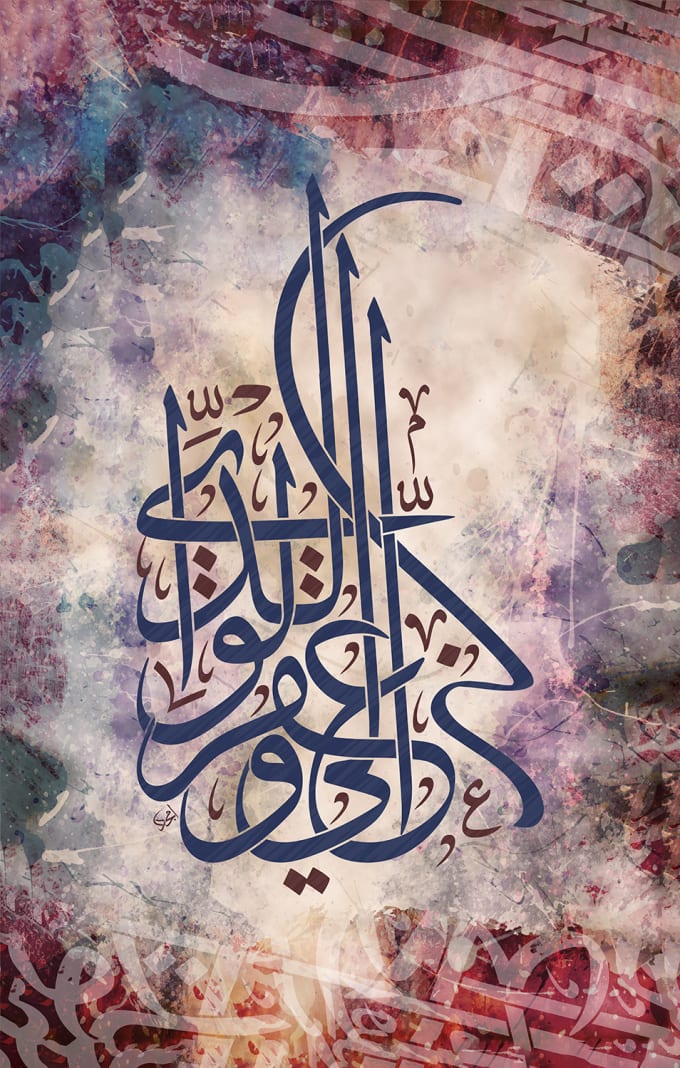


Only three of the vowels are in written form, and the others are represented by symbols.

When thinking of the alphabet, as in the ABC’s as a lot of us know it, Arabic instead uses symbols or dots above certain letter shapes to identify letter shapes and/or pronunciation of their alphabet. Interestingly, even though you’re spelling your name (proper noun), there are no capital letters in Arabic calligraphy. To write your name in Arabic calligraphy will require studying these various letter shapes, of which there are 18. The lines, which may or may not be connected to each other, form letter shapes instead of actual letters. If you’ve ever seen Arabic calligraphy, it is very elegant due to its use of various swags, symbols and lines. Since there are Muslim groups who oppose any art form depicting people or living things, calligraphy continues to be a much cherished art form for them. Calligraphy, in general, is still used in some Arab nations for religious writings and documents, in addition to art. Arabic calligraphy has been around for thousands of years and was one of the earliest forms of calligraphy that is still in practice today.
#ARABIC CALLIGRAPHER HOW TO#
One of the most popular goals when studying calligraphy is learning how to write your name in Arabic calligraphy. In a budget friendly way you can have a piece of Arabic art customized for your personal or commercial needs. An additional service for writing baby names can be found here. You can control the color of the background and ink, and the size of the final piece, to fit your needs. You can have your name or company’s logo scripted and written from a large variety of calligraphic styles, such as Naskh, Diwani, Thuluth, Reqaa, Farsi (Nastaleeq) and Kufic. Our website allows people with no knowledge of the Islamic arts or Arabic calligraphy to learn more about this form of expression. Arabic calligraphy also provides a spiritual connection for those, who derive its sanctity from the Holy Qur’an and Hadith, vital to understanding Muslim culture and art. This is evident especially in the Muslim world, where houses are decorated with framed calligraphy, mosques are adorned with it all over their walls, and millions of books and other publications have been written in one calligraphic script or another. It takes elegance, creativity, and discipline to be able to write one of the world’s most beautiful languages in this way.Īrabic calligraphy holds a significant cultural value for many, and has become an essential element in their lives. Arabic calligraphy is both an art and a science. It is co-sponsored by the School of Art the Departments of Religious Studies, History, Modern Foreign Languages and Literatures, English, and Political Science the Marco Institute for Medieval and Renaissance Studies and the Fern and Manfred Steinfeld Program in Judaic Studies.Our mission is to introduce the art and aesthetics of Arabic calligraphy to new people, Arabic or foreign, and by starting with writing their names, we hope to bring attention to this lesser known art form. UT’s Middle East Studies Program is hosting the event. His diploma was signed by Hassan Çelebi, Ferhat Kurlu, and Nuria García, who are among the most respected master calligraphers in the world. He received his icazet, or calligraphy diploma, in the Sülüs and Nesih styles at the Center for Research of Islamic History, Art and Culture in Istanbul. They will also learn about the traditional pedagogy of the Turkish and Arab calligraphic traditions.Ĭasado, a native of Madrid, Spain, trained in the Ottoman school of calligraphy, which traces its roots to the 16th century. Students will get an introduction to Arabic letters and their forms, and learn about some of the classical styles of Arabic calligraphy as well as the proper use of traditional materials to practice calligraphy. While on campus, Casado also will hold a two-day Arabic calligraphy workshop for interested UT undergraduate students. The event will be held in Room 253 of John C. Casado also will give a demonstration of Arabic calligraphy. The talk, “Preserving a Tradition,” will introduce the history of Arabic calligraphy and the ways this art is passed down from master to student. Master Arabic calligrapher Pablo Casado will give a public lecture at 7 p.m.


 0 kommentar(er)
0 kommentar(er)
